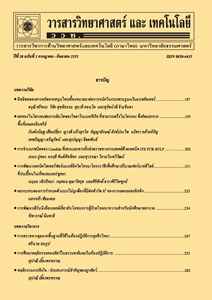ผลของสารควบคุมการเจริญเติบโตต่อการเพิ่มจำนวนยอดและการชักนำให้เกิดรากของกะเพราแดงในสภาพปลอดเชื้อ
Main Article Content
Abstract
Abstract
Ocimum sanctum L. is a medicinal plant that contains high antioxidant activity. Under natural conditions, genetic variation always occurs because of cross-pollination among genus. However, plant tissue culture can provide a number of plants with genetic stability. Therefore, the objective of this study was to investigate the effect of plant growth regulators on shoot multiplication from single node explants and root induction of O. sanctum under aseptic conditions. For shoot multiplication, single node explants were cultured on MS (Murashige and Skoog) medium supplemented with 0, 0.5, 1.0, 1.5 and 2.0 mg/L BA (6-benzyladenine) in combination with 0 and 0.5 mg/L IAA (indole-3-acetic acid) or NAA (1-naphthylacetic acid) for 4 weeks. The results showed that 100 % shoot proliferation occurred on all tested media. However, supplementation with IAA and NAA resulted in callus formation at the base of the shoot. The number of shoots, shoot length and number of nodes per shoot obtained on MS medium supplemented with 0.5 mg/L BA of 3.00±0.43 shoots, 0.71±0.24 cm and 1.81±0.26 nodes, respectively. For root induction, the shoots cultured on ½ MS or MS medium supplemented with 0 1.0 or 1.5 mg/L NAA and IBA (indole-3-butyric acid) for 4 weeks performed 100 % of root formation but NAA also resulted in callus at the base of the shoot. The number of roots and root length obtained on ½ MS medium of 12.2±4.20 roots and 2.08±0.29 cm, respectively.
Keywords: Ocimum sanctum L.; shoot multiplication; root induction; cytokinin; auxin
Article Details
References
[2] Mukherjee, P.K., Maitib, K. and Houghton, P.J., 2006, Leads from Indian medicinal plants with hypoglycemic potential, J. Ethnopharm. 106: 1-28.
[3] Ramesh, B. and Satakopan, N.V., 2010, Antioxidant activities of hydroalcoholic extract of Ocimum sanctum against cadmium induced toxicity in rats, Indian J. Clin. Biochem. 25: 307-310.
[4] Kayastha, L.B., 2014, Queen of herbs tulsi (Ocimum sanctum) removes impurities from water and plays disinfectant role, J. Med. Plants Stud. 2: 1-8.
[5] Gupta, S.K., Prakash, J. and Sriuastava, S.V., 2002, Validation of claim of tulsi, Ocimum sanctum Linn. as a medicinal plant, Indian J. Exp. Biol. 40: 765-773.
[6] Singh, N.K. and Sehgal, C.B., 1999, Micropropagation of holy basil (Ocimum sanctum Linn.) from young inflorescence of mature plants, Plant Growth Regul. 29: 161-166.
[7] Mishra T., 2015, Protocol establishment for multiplication and regeneration of ‘Holy Basil’ (Ocimum sanctum Linn): An important medicinal plant with high religious value in India, J. Med. Plants Stud. 3: 16-19.
[8] รังสฤษดิ์ กาวีต๊ะ, 2540, การเพาะเลี้ยงเนื้อเยื่อพืช หลักการและเทคนิค, ภาควิชาพืชไร่นา คณะเกษตร มหาวิทยาลัยเกษตรศาสตร์, กรุงเทพฯ, 219 น.
[9] ศิวพงศ์ จำรัสพันธุ์, 2546, การเพาะเลี้ยงเนื้อเยื่อพืช, คณะวิทยาศาสตร์และเทคโนโลยี สถาบันราชภัฏอุดรธานี, อุดรธานี, 308 น.
[10] Jamal, M.A.H.M., Sharif, I.H., Shakil, Md.M., Rahman, A.N.M.R., Banu, N.A., Islam, Md.R. and Nazmuzzaman, Md., 2016, In vitro regeneration of a common medicinal plant, Ocimum sanctum L. for mass propagation, Afr. J. Biotechnol. 15: 1269-1275.
[11] Gopi, C., Sekhar, Y.N. and Ponmurugan, P., 2006. In vitro multiplication of Ocimum gratissimum L. through direct regeneration, Afr. J. Biotechnol. 5: 723-72.
[12] Banu, L.A. and Bari, M.A., 2007, Protocol establishment for multiplication and regeneration of Ocimum sanctum L. an important medicinal plant with high religious value in Bangladesh, J. Plant Sci. 2: 530-537.
[13] Sharma, N.K., Choudhary, R.C. and Kumar, M., 2014, An improved plant regeneration system of Ocimum sanctum L- An important Indian holy basil plant, J. Cell Tissue Res. 14: 4143-4148.
[14] คำนูณ กาญจนภูมิ, 2542, การเพาะเลี้ยงเนื้อเยื่อพืช, สำนักพิมพ์แห่งจุฬาลงกรณ์มหาวิทยาลัย, กรุงเทพฯ, 162 น.
[15] Pattnaik, S. and Chand P.K., 1996, In vitro propagation of the medicinal herbs Ocimum americanum L. syn. O. canum Sims. (hoary basil) and Ocimum sanctum L. (holy basil), Plant Cell Rep. 15: 846-850.
[16] Çiğ, A. and Başdoğan, G., 2015, In vitro propagation techniques for some geophyte ornamental plants with high economic value, Int. J. Second. Metab. 2: 27-49.


